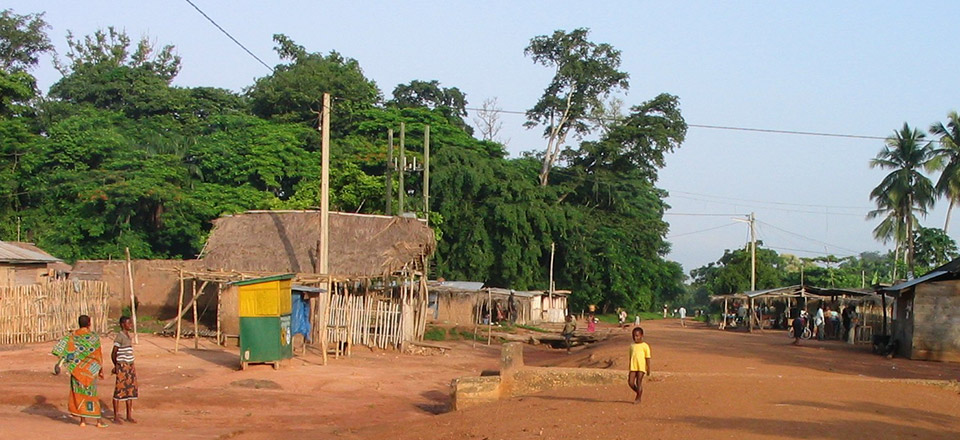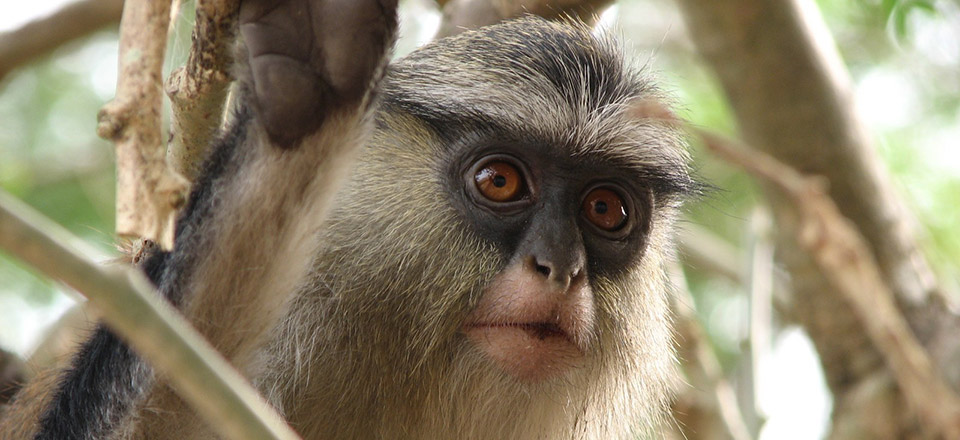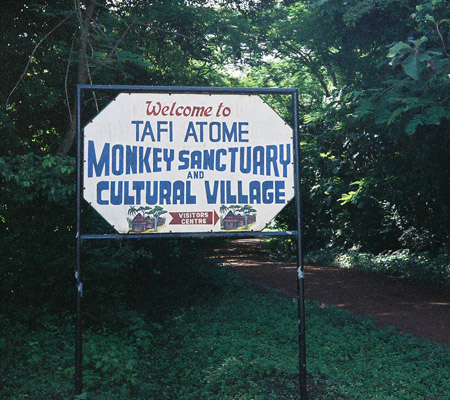The village of Tafi Atome has over 1000 residents and is located within the Hohoe District of the Volta Region of Ghana. Residents speak Ewe. The village is surrounded by a sacred grove of approximately 28 ha. The grove is a semi-deciduous forest and lies within the forest-savannah transitional zone. It is immediately surrounded by grassland and cultivated farmland. The grove fits into the IUCN protected area Category IV, a habitat and/or species management area. The area is protected by a 2006 Hohoe District bylaw for its main value as habitat for sacred mona monkeys (Cercopithecus mona mona).
According to residents, approximately 200 years ago, the ancestors of the residents of the Tafi Atome area are said to have migrated from Assini in central Ghana to the Hohoe District. They brought with them an idol or fetish that was placed in the sacred forest in Tafi Atome, in order to keep it safe and cool. The forest was immediately considered sacred and therefore protected. A short time after their arrival in the area, the village residents began to notice monkeys that they believed they had seen in their original region of Assini, and therefore believed that the monkeys had followed them. The monkeys were henceforth considered ‘representatives of the gods’, and protected as sacred.
In the 1980s, a local Christian leader brought opposing views to traditional law, which led to the deterioration of spiritual connections with the fetish forest and erosion of traditional protection. Residents cut down economically viable trees, particularly around the sacred grove, until an environmental organization helped re-affirm protection of the grove in the 1990s. There is ongoing pressure from local residents to clear the forests for farmland and to cut trees. There is also tourism pressure to feed the mona monkeys.
Threatened, there is on-going pressure from local residents to clear the forests for farmland.
Coalition
The community, including the Tourism Management Committee, works with organizations including the Nature Conservation Research Centre (NCRC) to pursue tourism in order to preserve the natural and cultural heritage of the sacred grove.
Action
In 1995, the Accra-based Nature Conservation Research Centre visited the village of Tafi Atome and found the sacred forest in a state of degradation. In 1996, a community-based ecotourism project was started in the village. In 1997, mahogany trees were planted to demarcate the boundary of the sanctuary in order to halt future encroachment of farmland upon the forest edge.
1n 1998, a tourist welcome centre was built to serve as the first point of contact for tourists arriving at the village. It was funded by the community and by external donors.
The opinion of the villagers was evaluated in surveys between 2004 and 2006.
Conservation Tools
Mention the conservation tools or approaches that have been used or developed to support the work on the sacred natural sites. These can be tools or methods used for inventory or monitoring of plants and animals or for developing community capacity and strengthening of cultural values of the site and its people. The use of planning tools and guidelines should also be mentioned, for example the IUCN UNESCO Sacred Natural Sites Guidelines for Protected Area Managers by Wild and McLeod.
Describe the most important policies and law that support or hinder the conservation of sacred natural sites and species. In 2006, the Hohoe District passed official bylaws including restrictions to enter the forest sanctuary, to damage trees, to farm within the protected area, or to kill animals in the grove.
Results
Community members participating in the 2004 and 2006 surveys said the cultural values of the community have improved as a result of tourism promotion. The arrival of tourists has also brought tourism income, which is distributed among stakeholders (e.g. fetish priest, chiefs) and used for community development, compensation for the landowners of the sanctuary, and educational funds.
- Ormsby A and Edelman, C. (2010) Community-based Ecotourism at Tafi Atome Monkey Sanctuary, a Sacred Natural Site in Ghana , in Verschuuren B., Wild R., McNeely JA. and Oviedo G. (eds) “Sacred Natural Sites : Conserving Nature and Culture” Earth Scan, London.
- Nature Conservation Research Centre (NCRC), Ghana: Visit Website
- Ntiamoa-Baidu, Y. (1995) Indigenous vs. Introduced biodiversity conservation strategies: the case of protected area systems in Ghana, African Biodiversity Series, 1, Biodiversity Support Program, Washington DC: Visit Website
- Ormsby, A. 2012. Perceptions of Tourism at Sacred Groves in Ghana and India. RASAALA: Recreation and Society in Africa, Asia and Latin America 3(1): 1-18.
- Ormsby, A. 2012. Cultural and Conservation Values of Sacred Forests in Ghana. p. 335-350 in Pungetti, G., G. Oviedo and D. Hooke (eds.) Sacred Species and Sites: Advances in Biocultural Conservation. Cambridge: Cambridge University Press. Get the Publication






